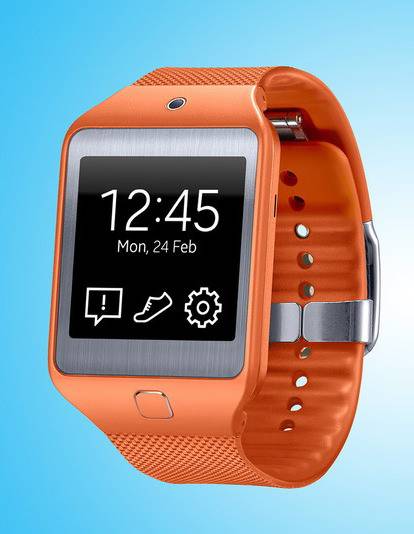I feel bad for anyone who actually bought a Galaxy Gear, the smartwatch Samsung just made obsolete with two new models of its second-generation Gear smartwatches. Obsolescence may be an indelible part of technology, but even here, five months is a whiplash-worthy product cycle.
Fast as their introductions may be, the Gear 2 and Gear 2 Neo are coming, Samsung announced Saturday. The South Korean tech company, which is expected to introduce the new devices on Monday at Mobile World Congress in Barcelona, made a few notable changes to its line of wearable gadgets. First, the “Galaxy” branding is gone. Also, the camera has moved—in the case of the Neo, completely off the device. But the biggest change has happened beneath the surface.
Looks like the company no longer believes Android belongs on our wrists. Instead, Samsung has pinned all its smartwatch dreams on its other passion project, the Tizen operating system.
Wearable Tizen

Think of Tizen as an alternative OS. Samsung has been interested in the open-source Linux operating system for years. It has been no secret that the tech maker has wanted to move away from Google and Android, and Tizen would be a viable and flexible option.
And yet, no major consumer Tizen products are on the market (apart from Samsung’s NX300M smart camera, though that’s arguably a niche product). Samsung has been promising a Tizen handset, but now, its smartwatches have become the first to hit the starting line. Makes sense.
Tizen smartphones have been a challenge, partly because it’s not easy to spur a rich environment of apps from scratch. But since these wearable products rely on pairing with phones, there’s less need for a comprehensive app store. A well-chosen selection, though limited, could still be enough to excite consumer interest.
See also: Why The All-In-One Smartwatch Isn’t Happening Any Time Soon
The company has made it clear that it sees Tizen going out across all kinds of devices, from phones and tablets to TVs and automobiles and other appliances. Now that there’s a Tizen smartwatch in the mix, putting all that together and controlling it all from your watch literally seems within arm’s reach.
What’s not clear yet is what the switch from Android to Tizen will mean to Gear apps. But it’s encouraging that Samsung listed several that will work with the Gear 2s—including Banjo, BMW, CNN, Conde Nast, Expedia, eBay, Evernote, Feedly, Garmin, Glympse, GM (OnStar), iControl, Line, Path, PayPal, RUNTASTIC, Volkswagen, Weather Channel and Under Armour. iHeart Radio also announced that it’s bringing digital radio to the watch.
And, in a move that likely means Samsung learned something from the first Gear’s launch, it also announced that both watches will work with dozens of its smartphones. Yay.
Gearing Up

The first Galaxy-dubbed Gear got a fair load of criticism, considering its high $300 price and narrow field of compatibility at launch. When it debuted, it only worked with recent Galaxy Note devices running Android 4.3. It also suffered from awkward design, with a camera embedded in an irreplaceable watchstrap.
With smartwatches becoming a hot category, I can see why Samsung would want to put a more viable contender on the market as soon as possible—particularly since Apple rumors of an iWatch (of some sort) have heated up again.
The Gear 2 and Gear 2 Neo are Samsung’s attempt to tackle these issues, and come with a few changes designed to court mainstream consumers.
The company’s interest in tech-fueled fitness, for example, gets a boost. The original had a pedometer and worked with more than 70 fitness apps. This time, the product designers also stuffed heart-rate sensors into the watches, which feature their own music players capable of funneling tunes to a Bluetooth headset.
Couch potatoes get a nod too. Like Samsung’s latest tablets and handsets, the watches come with infrared sensor that can control TVs.
The camera, a 2 MP shooter, moves off the watchband (as awkwardly placed on the first-generation Gear) and onto the device itself—at least for the Gear 2. Whether this will make the camera more usable is anyone’s guess right now, but I suspect a little hands-on time will answer that pretty quickly. The Gear 2 Neo foregoes the camera altogether, which allows it to shave off a little girth and weight.
Both models have a 1.63-inch Super AMOLED display and have a little more power under the hood, with a dual-core 1GHz chip. (The Galaxy Gear had a 800MHz processor.) Memory and storage remain the same, at 512 MB RAM and 4GB, and dismal three-day “if you’re lucky” battery life looks to be about the same. No surprise there, as the battery size looks unchanged. On the plus side, people with Dick Tracy watchphone aspirations can still make or answer calls from their wrist, thanks to a microphone and small speaker. The watches also come in different colors.
The specs speak to Samsung’s desire to recreate the smartphone experience on the wrist. In the first iteration of the Galaxy Gear, that led to a bulky device with poor battery life and performance issues. If Tizen is able to cure those woes, then perhaps Samsung has stumbled onto the key for the all-in-one smartwatch that consumers have been looking for.
No word on prices yet, but the Gear 2 Neo will likely cost less, which would answer critics who have blasted Samsung’s previous $300 price point. When it launches for retail availability in April, the Gears will enter a space rife with competitors like Pebble, which just released a snazzy new stainless version called Pebble Steel, as well as products from Sony, Qualcomm and others.
Unlike the smartphone field, there are no clear winners or losers in smartwatches yet. This means 2014 could be the year that defines this category—which could explain why Samsung’s in such a hurry to get its gear together.

















